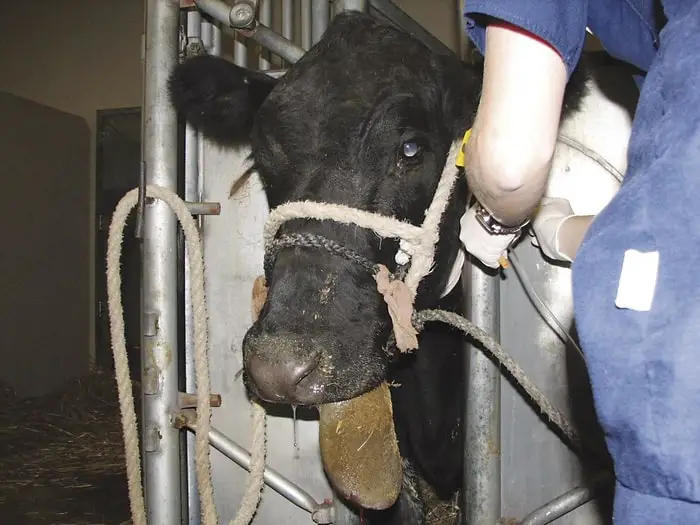Woody tongue in cattle or Actinobacillosis is a chronic infectious disease of animals, especially cattle and goats. The disease is characterized by the inflammation of the tongue, lips, gums, palate, and pharyngeal lymph nodes. In addition, the disease may cause lesions in the larynx, esophagus, rumen, and reticulum, liver, lungs, and serous membrane. The disease is also called ‘wooden tongue,’ or Big Head, Timber Tongue, or Botryomycoses.
Important Information on Woody Tongue in Cattle
Actinobacillosis is a common bacterial disease of cattle and many farm animals. The sources of infection are mainly the discharge from the infected lesions of the affected animals. Contaminated fodder or water may transmit the organism to healthy animals. The injury to the buccal mucosa by sharp foreign objects or abrasive feedstuff may help spread the disease. The disease is reported in many countries sporadically.

Causes of Woody Tongue in Cattle
The causal agent of Wooden Tonge in cattle is Actinobacillus spp, a small non-motile, gram-negative rod, appearing singly or as short chains in the abscess. The causal agent of the disease in Cattle and Sheep is Actinobacillus lignieresi, Actinobacillus equuli in horses, Actinobacillus suis in pigs, Actinobacillus seminis in rams, and Actinobacillus salpingitis in chickens.
Pathogenesis of Actinobacillosis in Cattle
The organism Actinobacillus commonly presents the oral cavity and upper digestive tract of healthy cattle. The pathogenesis of the disease are as follows:
- Organisms are normal inhabitants of the mouth, digestive tract, and upper respiratory tract.
- The bacteria gain entry into the mucous membrane through ulcers, wounds, or other injuries to the mucosa.
- The organism causes local infection in the soft tissue, resulting in the acute inflammatory reaction, leading to granulomatous lesions.
- There is necrosis and suppuration of the tissues with the discharge of pus to the exterior.
- The infection transmits to the regional lymph nodes.
Clinical Signs and Symptoms of Woody Tongue
The disease is ordinarily chronic and affects mainly soft tissues of the mouth, tongue, lymph nodes of the buccal cavity, upper digestive tract, rumen, and reticulum. The cutaneous form of the disease causes
- Circumscribed, diffuse, or multiple swelling in the submaxillary or parotid region’s lymph glands or subcutaneous tissues.
- When the tongue is involved, there is profuse salivation and difficult mastication.
- Usually, the base of the tongue is swollen, with the tip often remaining normal. In the later stage of the disease, the tongue got distorted.
- There may be few ulcers on the side of the tongue.
- Swellings are neither hot nor painful and are not attached to the bones.
- In the later stage, the acute inflammation is replaced by the fibrous tissues.
- There will be palpable enlargement of the submaxillary and parotid glands.
- IIn the case of acute Actinobacillosis, the lesions are found in the mouth, chest wall, and thigh regions.
- In the case of the involvement of the pharyngeal ring, there is respiratory dyspnea.
- In acute cases, the animal died due to starvation and dehydration.
Pathological Lesions of Actinobacillosis in Cattle
The most common pathological lesions of the wooden tongue are:
- Abscesses are seen in the soft tissues, usually mandibular lymph nodes of the head.
- There may be abscesses in the larynx, esophagus, rumen, reticulum, liver, lungs, serous membrane.
- Abscesses contain thick, tenacious, yellow-green, odorless pus around the local lesions.
- The pus contains sand-like numerous granules referred to as ‘sulfur granules.’
Diagnosis of Woody Tongue in Cattle
The bacterial disease can be diagnosed in the following ways:
- History of feeding coarse hay or injuries in the oral cavity.
- From the clinical signs and symptoms.
- Granules can be felt in the exudated but are very small and not usually visible without magnification.
- The granules on staining reveal clusters of small gram-negative rods referred to as “club colonies.”
- Clusters and the use of differential media can identify Actinobacillus lignieresii.
Differential Diagnosis of Actinobacillosis in Cattle
The disease is confused with the following disease, and you must be differentiated from them:
- Actinomycosis is caused by Actinomycoses bovis and affects mainly hard tissues and is called Lumpy Jaw.
- Injuries by a foreign body in the mouth.
- Lymphomatosis in cattle.
- Mandibular abscess.
- Tuberculosis caused by Mycobacterium tuberculosis, and that affects multiple organs and systems.
Treatment and Management of Woody Tongue in cattle
The wooden tongue is mainly a chronic disease and can be cured by proper treatment and management. The treatment procedures are as follows:
- Opening and draining of abscess where possible.
- Packing of the wound with tincture of iodine.
- Subcutaneous injection or application of Lugol’s iodine directly into the diseased tissues.
- Intravenous injection of iodine salt.
- Sulfonamides, penicillin, streptomycin, and other broad-spectrum antibiotics.
Prevention and Control of Actinobacillosis in Cattle
The disease can be prevented, and you can control the spread of the disease on your farm by taking the following measures:
- Prompt attention on mouth lesions and use of soft feed.
- Treatment of the affected animals and prevention of contamination of pasture and feed troughs by the organisms.
- Isolation and disposal of affected animals.
Final Talk on Wooden Tongue in Cattle
The wooden tongue is a common bacterial disease in cattle and other domestic animals. The organism is the typical inhabitants of the oral cavity and upper GI tract of animals and enters the circulation by the wound. The organism mainly affects the soft tissues of the digestive tract, lymph nodes, and sometimes the cutaneous tissues. The disease is mainly chronic and creates fibrinous tissues in the soft tissues of the oral cavity. As a result, the tongue of the animal becomes hard and called ‘Wooden Tongue.’ The disease can be cured by proper treatment and management.